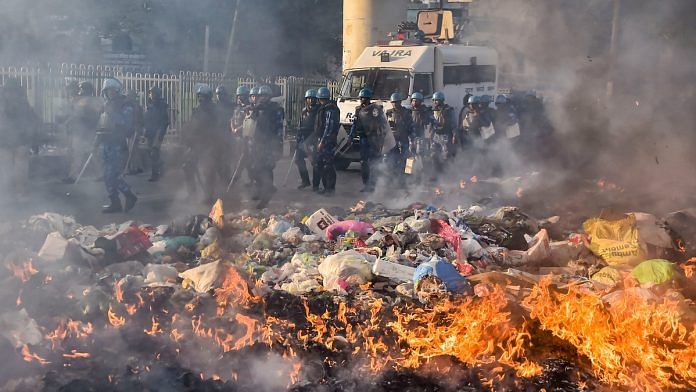New Delhi: Delhi Chief Minister Arvind Kejriwal Wednesday called on the central government to send in the Army as the death toll in the communal riots in the Northeast district rose to 24. Kejriwal said the police were unable to control the situation or instill confidence in citizens.
His statement has brought the Delhi Police in focus again, which has been receiving flak for incidents of violent protests since December.
However, the process to deploy the Army to tackle a breakdown of law and order or natural calamity differs in the national capital when compared to other states. ThePrint explains.
How it works in Delhi
Delhi is one of 53 cities — including Mumbai, Hyderabad, Lucknow, Noida and Kolkata — that follows the commissionerate system, where the Commissioner of Police (CP) does not report to the District Magistrate (DM) but directly to the state government. The CP is responsible for the city’s police force, and has magisterial powers related to regulation, control, and licensing.
What distinguishes Delhi from the 52 other commissionerates is that Delhi Police is under the central government and not the state government.
So, in Delhi, the process of deploying the Army requires the Deputy Commissioner of Police to first request the CP. From there, the request is forwarded to the Lieutenant Governor, who then calls the home ministry, explained former Commissioner of Delhi Police Neeraj Kumar.
In the other commissionerates, the CP’s request goes to the state government and then on to the Union Ministry of Home Affairs.
In cities that are not commissionerates, the police come under the state list as mandated under the 7th Schedule of the Constitution, which means a dual system exists in which the Superintendent of Police has to work with the District Magistrate (DM).
In case of a Union Territory, it is the chief secretary who requisitions the Army after approval from the Lieutenant Governor, said N.R. Wasan, a retired IPS officer and former NIA special director.
“The last time the Army was called in (in Delhi) was during the 1984 riots when the whole city was burning. The current situation is a sheer contrast of 1984. It is very localised and only in one district of the city. The police should be able to contain it,” Kumar told ThePrint.
Also read: Who is to blame for CAA violence: Delhi Police or politics of Modi government?
Deploying Army in other states
Section 130 and Section 131 of the Code of Criminal Procedure deal with the use of armed forces to disperse a crowd of people. Under Section 130, if the dispersal of the crowd is necessary for public security, then an executive magistrate makes the request. Executive magistrates are appointed by the state government. A DM is usually picked from the appointed executive magistrates.
In states when there is a breakdown of law and order, for example in case of a riot or natural calamity, then the district magistrate can approach the military commander of the area.
In his book Decoding Intolerance: Riots and the Emergence of Terrorism in India, former Indore district magistrate Pradeep Lahiri wrote, “At the district level, if the DM judges the situation to be such that the military should be called in, he can approach the military commander of the area and request for the military to be deployed under his jurisdiction. The Army contingent then must be made available as soon as possible.”
Lahiri added that the DM’s requisition also has to be confirmed by the state government.
In 1967, while Lahiri was the DM in Indore, he had requisitioned for the Army during a riot situation. However, the local police were unhappy as police officers tend to view the move as a vote of no-confidence in their abilities.
Army assistance has been requested for in several instances over the years. During the sectarian clashes in Siliguri in September 2007, the Darjeeling District Magistrate had asked for the Army. In Vadodara in May 2006, the Army was called following communal violence. Later in October that year, the Army was called in Gharsana (Rajasthan) when there was no availability of adequate water for irrigation.
Also read: ‘Hinduon ki ladayi hai… record mat kijiye’ — journalists under attack in Delhi violence







Indian army the bast of wrold